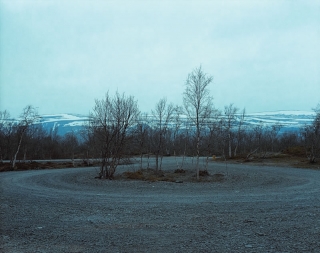Siggen Stinessen, Johan Sandborg, Per Berntsen and Jens Hauge: "Norsk Landskap Nr. 16, Birkestrand II, Finnmark", Norsk Landskap
A Trip through an Ordinary Norwegian Landscape: Perspectives on Photography’s role in Contemporary Art (PhD-thesis) discusses photography’s diverse and often controversial role in contemporary art, and examines the position of the photograph as art object, document, and “ready-made” artifact. The main piece discussed in the dissertation is Norsk Landskap 1987 (Norwegian Landscape 1987), a collaborative project by Johan Sandborg, Siggen Stinessen, Jens Hauge and Per Berntsen. The photographic work was exhibited at Henie Onstad Art Centre in 1987. Norsk Landskap 1987 was conceived during an 18-day car trip in Norway in which the aim of the artists was to redefine the Norwegian landscape by focusing on the unspectacular and the ordinary. The work does not easily lend itself to art historical categorization, since it has clear conceptual features, but simultaneously sets out to introduce alternative aesthetics by focusing on detailed renderings of ordinary landscapes. It is thus seemingly postmodern, but at the same time displays several modernist features. By using Norsk Landskap 1987 as a prism, this dissertation discusses a range of different issues, including changing ideas of landscape and questions concerning the formation of national identity. It also explores what role photography played in the re-evaluation of the human-altered landscape that took place from the 1960s onwards. It thoroughly analyzes the reception of conceptual photography in Norway, the relationship between modernism and postmodernism, and Norwegian photography in connection to the international art scene. In doing so, the dissertation raises the problematic implications of preserving strong conceptual distinctions, and examines how art criticism and postmodern theories have assisted in cementing these distinctions.
The dissertation concludes that the issues that it raises have been closely and continuously attached to photography’s unsettled status, in which at one moment it is seen as art, in the next as record, and in a third as a so-called ready-made artifact. Photography’s mechanical features have constantly constituted a challenge for those who want to ascribe it the status of art, and the question of the extent to which a photographer’s thoughts and intentions are manifested in the photographic process, and how, is an important one. These issues have been a recurrent theme in discussions on photography since the medium was introduced to the public in the first part of the 19th century, and continue to haunt us today. Photography’s greatest strength and weakness appears to be that it is never “art” enough.
